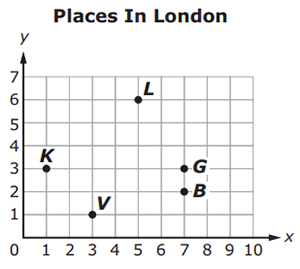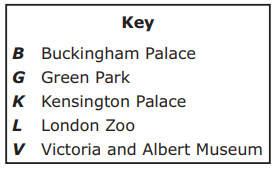Represent real world and mathematical problems by graphing points
in the first quadrant of the coordinate plane, and interpret coordinate
values of points in the context of the situation.
| Name |
Description |
| Voter Turnout and the 19th Amendment | Students will graph and analyze voting data to explain how the 19th Amendment expanded civic participation in this lesson plan. |
| Voter Turnout and the 15th Amendment | In this lesson plan, students will graph and analyze voting data to explain how the 15th Amendment expanded civic participation. |
| Coding Geometry Challenge # 16, 18 & 19 | This set of geometry challenges focuses on creating a variety of polygons using the coordinate plane as students problem solve and think as they learn to code using block coding software. Student will need to use their knowledge of the attributes of polygons and mathematical principals of geometry to accomplish the given challenges. The challenges start out fairly simple and move to more complex situations in which students can explore at their own pace or work as a team. Computer Science standards are seamlessly intertwined with the math standards while providing “Step it up!” and “Jump it up!” opportunities to increase rigor. |
| Weather: What is Air Pressure? | What is air pressure? This set of experiments will explore the properties of air to determine how its behavior affects the weather.
Students will make conclusions about the properties of air based on the data they've recorded from their experiments.
This is lesson 1 for the air pressure component of a 5th grade unit on weather. The lesson uses weather sensors and connects computer science concepts within the lesson. |
| Weather: How Does Temperature Affect Air? | In this lesson students will perform experiments and collect data to gather empirical evidence about how air molecules behave when heated and cooled. This is the 4th lesson in the 5th grade unit and uses sensors and computer science skills to learn about weather. |
| Transfer The Heat | This lesson introduces how heat transfers to different substances using an electrical device. The electrical device used create thermal energy changes a substance’s state of matter. This lesson contains a lab experiment that tests the timing at which butter changes to its melting point while using a lamp. This lab questions whether using a different electric device will conclude the same results.
This is lesson 3 in the Detecting Electrical and Thermal Energy Unit. |
| Check The Temperature | This lesson introduces the different states of matter for any substance. For this lesson students will be allowed to observe the changes water makes during the following states: solid, liquid, and gas. Students will engage in discussion to predict the temperature when a substance changes from solid to liquid and liquid to gas. Lastly, students will learn the advantages of using a line graph to analyze the relationship between two variables.
This is lesson 2 in a Unit on Detecting Thermal & Electrical Energy. |
| Weather: How Does Air Warm Up? | This experiment will model how sunlight striking the Earth’s surface warms the air around us. Students will investigate how surfaces of differing reflectivity determine how much sunlight is absorbed and converted to heat which in turn serves to warm the adjacent air.
This is lesson 3 in the fifth grade unit on weather. The lesson uses weather sensors and connects computer science concepts within the lesson. |
| Weather: Water Vapor in Our Atmosphere | Learn about relative humidity: how to measure it, what causes it to change, and why it is an important component of our weather. This is lesson 2 in a fifth grade unit on weather and has two inquiry based experiments for students. The lesson uses weather sensors and connects computer science concepts within the lesson |
| Heatin' It Up or Coolin' It Down | Many chemical reactions are accompanied by a change in temperature. Whether it is extreme or barely noticeable, the temperature may go up or it may go down. Investigate these two chemical reactions described in this lesson to experience two different kinds of temperature change.
|
| How Does Force Affect Motion? | Students will explore how force affects an object's motion. Students will discuss how the greater the mass of an object, the greater the force required to move an object. Students will use data gathered through experimentation to justify their reasoning and understanding of forces and motion. |
| Where's the Weather? | In this open inquiry lesson, student groups will try to identify an unknown location by incorporating data analysis and environmental weather patterns such as precipitation and temperature. Students will have to determine if the mystery location is a swamp, a desert, or a mountain by reviewing the given weather data. Students will have to justify their reasoning in writing to their peers. |
| Did you slow the flow, Joe? | Students will identify the effects of friction on the falling rates of an object in different liquids using speed calculation. With these calculations, the students will synthesize a cause/effect statement from the results comparing thickness (viscosity) of the liquid and the speed on a falling object. |
| Graphy Graphy | In this lesson, students will learn how to create a situational story problem using two coordinate points on a grid. The students will then be able to plot and describe the path traveled from the starting point to the destination based on the information presented in the situation. |
| Keeping Your Cool With Your Lunch Bag | On this MEA activity, students will create a procedure to rank five lunch bags as to which one is the best in keeping food and drinks at a safe temperature and appealing to the taste, while keeping design and price on target.
Model Eliciting Activities, MEAs, are open-ended, interdisciplinary problem-solving activities that are meant to reveal students’ thinking about the concepts embedded in realistic situations. Click here to learn more about MEAs and how they can transform your classroom. |
| Dig That Grid! | In this lesson, students will use their knowledge of coordinates and coordinate pairs in a real life situation as they become archaeologists excavating a dig site. They will measure their site, label the grids with correct coordinates and use coordinate pairs to record the location of the artifacts they discover. |
| Map It Out!! | In this lesson, students will use real life maps and apply their knowledge of coordinates (ordered pairs) in order to identify and name specific locations on a map and explain the relevance to their life. |
| Property Picking Pickle | Students will graph points on a coordinate plane to help them to determine which property would be best suited for a recreational building. This lesson has students practice graphing points, as well as challenging their critical thinking skills with a real world problem. Model Eliciting Activities, MEAs, are open-ended, interdisciplinary problem-solving activities that are meant to reveal students’ thinking about the concepts embedded in realistic situations. Click here to learn more about MEAs and how they can transform your classroom. |


